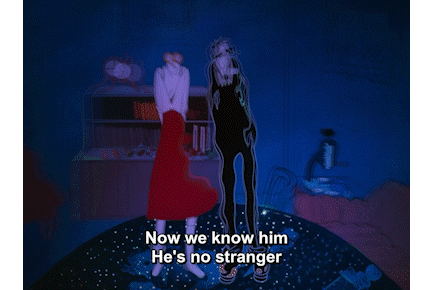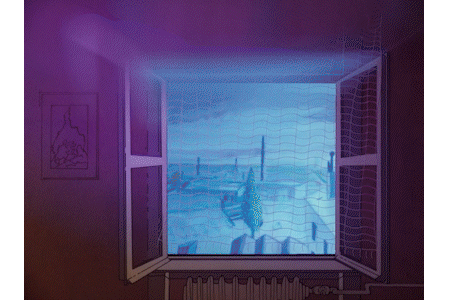Habfürdö is unique. I’ve never seen a film like it.
An experimental animated Eastern Bloc neo-constructivist musical romantic soap opera (ugh, one of those), it was directed by György Kovásznai, produced by Budapest’s Pannónia Filmstúdió, and watched by apparently no-one. Its commercial failure in 1980 dealt a crippling blow to adult animation in Hungary, but now it’s a beloved curio for fans of the bizarre. If you’ve seen Les Maîtres du temps and Fehérlófia and want to delve further into Hungarian animation, consider cleaning yourself off with a bubble bath.
The film’s most striking aspect is its animation style: it doesn’t have one. The action rictus-spasms at 24 fps from Hergé-style Ligne claire to Dali-style surrealism to Picasso-style cubism to scrapbook collages to real-life footage. Anything goes, and it’s probably for the best that most of the film happens inside one room. Visual comprehensibility is in short supply and we need all the visual aids we can get.
Habfürdö‘s characters slip and squirm through poses like amoebas jolted with electricity. They exist in permanent flux, morphing to reflect their emotions (this gives us a window into what they’re actually thinking; as opposed to their dialog, which is largely a tissue of self-deceptive bullshit.)

Admittedly, “characters changing shape to reflect their emotions” is the oldest trick in the book, but I’ve never seen it done to the extent that Habfürdö does it. In animation, “off-model” refers to when a character deviates from a standard model sheet. Habfurdo’s characters have no model to be “off” from.
What about the story?
The plot could fit on a postcard. Zoltan Mohai, an preening, pretentious “artist”, has cold feet on his wedding day. He hides from the bride at the house of a medical student, whom he burdens with breaking the news that the wedding is cancelled.
I’m not sure why it’s called Bubble Bath (aside from the fact that Zsolt briefly hides inside one). Maybe it’s a clue to the nature of the social relations on the screen. These are vain, silly people living comfortable middle-class lives. People inside bubbles, in other words, one needle-prick away from existential extinction. And although the scenario generates complications (the jilted bride misunderstands what’s happening, and Anna begins having feelings for this preening stranger herself), it’s ultimately all nonsense, a churned-up froth that dissolves on contact with reality.
Technically, Habfurdo is an “idiot plot”—the whole situation would be defused if these people would have one conversation. But the fact is, they can’t. They refuse to confront who they are, and what they actually want.
Why does Zsolt want to escape his marriage to Klára Horváth? Mainly because of a perceived insult from her family. Her mother or someone once referred to him as a “window dresser”, which wounds his pride (he’s a serious artiste!). Yet…it’s true that he’s a window dresser. When he barges in through Anna Parádi’s front door, that’s how he introduces himself! He’s locked in a roomful of mirrors, despising his own reflection.
Likewise, Klára’s marriage-obsession (and sexual promiscuity) come from a desire to project a certain self-image to her social circle. She gloats that the “old maids” at the hospital where she works at are jealous of her debutante’s lifestyle. In the end, she’s making decisions because of what other people think. Left to her own devices, she’ll construct a relationship that’s flawless from the outside and miserable to the ones trapped inside it.
Economist John Maynard Keynes once imagined a beauty contest where women are judged by a panel. The twist: each of the judges is rewarded if their chosen woman is the overall winner. This scenario (which Keynes applied to the stock market) would quickly devolve into farce. The judges would ignore their own preferences, and would only think of of what the other judges prefer. It wouldn’t be a contest of beautiful women, it would be a contest of judges who are judging beautiful women. Today, we call that sort of problem Goodhart’s Law. When a measure becomes a target, it ceases to be useful as a measure. Klára doesn’t care about her own happiness. She only cares that the “judges” (her social peers) think she’s happy.
Habfürdö isn’t a character study. There is no effort at psychological realism. Characters are written the way they are drawn: as ludicrous, bizarre freaks. Everything they do is abhorrently strange, yet we see the social parallels.
The dirty secret behind animation (even “realistic” animation) is that it’s essentially a bag of tricks. Think of the “Milt Kahl head swaggle”. When have you ever seen this gesture in real life? Or the Dreamworks Face. If you saw a real person make that expression, you’d assume they were suffering a stroke. But when those things appear in an animated world, we assign meaning to them. (head swaggle = character has smug confidence, Dreamworks face = character is sassy and full of ‘TUDE and also you should probably skip this movie). They are visual shorthand. They don’t depict real life, they hint at it.
Habfürdö’s characters are written in the same stylized way: unrealistic on the face of things, but it nudges your mind to toward topics that are too realistic for comfort. It’s the old divide of how you can be truthful without exactly being factual. More than anything, Habfürdö is a truthful film. Bubbles might seem insubstantial, but they hint at a powerful chemical reaction. Ignore them at your peril.
You soon discern that the point of the movie isn’t these characters, it’s modernity, and urbanism, and the pressures faced by men and women who live like termites in gray apartment complexes. I’m sure that it would make more sense to someone raised in the land of “Ghoulash communism”. I got the sense that much of the film was flying over my head.
But Habfürdö mostly doesn’t take itself seriously. The plot is casually constructed. A fourth character is introduced, a boxer called Nandi. He is absolutely pointless. He ends up getting drunk and passing out.
And sometimes the movie’s experimental nature excuses its excesses. The film begins with a wildly overambitious 3D panning shot over medical student Anna Parádi’s apartment. In a Disney movie, it would have looked inexcusably sloppy. In the context of Habfürdö’s abstract style, it works.

Habfurdo is an odd beast. Even now, I’m not sure I have a handle on what it’s trying to do. Habfürdö‘s visuals have a restless joy that infects the viewer. It makes me happy. I think that’s enough!
No Comments »
Comments are moderated and may take up to 24 hours to appear.
No comments yet.

